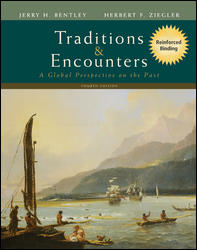Traditions and Encounters, 4th Edition (Bentley)Chapter 23:
TRANSOCEANIC ENCOUNTERS AND GLOBAL CONNECTIONS
Before 1500, there was considerable cross-cultural interaction between Europe and Asia and, to a lesser extent, with sub-Saharan Africa. With the voyages of discovery of the fifteenth century, these contacts accelerated and became global in reach. Russian adventurers built an empire that stretched across Eurasia, and they began to explore in the Pacific Ocean basin. Meanwhile, the Chinese and the Ottomans ventured into and explored the Indian Ocean basin. The impact of European contact on the previously isolated societies of the Americas and the Pacific Islands was profound and devastating and will be discussed in detail in Chapter 25. This chapter considers the motives and methods of European trade and exploration between the fifteenth and the eighteenth centuries. Some common themes of this era include:
- Mixed motives. European explorers acted from a complex mix of greed, daring, and missionary zeal. Christian princes, such as Prince Henry of Portugal, and Ferdinand and Isabel of Spain, underwrote voyages to expand Christianity. Equally compelling were the profits to be made in the spice trade, especially if Arab intermediaries could be eliminated.
- New technologies used in navigation. From Arab traders, the Portuguese borrowed the astrolabe and the cross staff and used these tools to determine their north/south position. Other new technologies included the magnetic compass, more flexible combinations of sails, improved shipbuilding, cannons, and more accurate navigational charts.
- Adventure. Curiosity and a sense of adventure also drew Europeans out into the world. Between 1500 and 1800, European mariners charted the oceans, seas, and coasts of the entire globe. Important geographic questions were resolved: the circumference of the earth, the quest for a northwest passage across North America, and the patterns of winds and currents.
- The Columbian Exchange. Contact with European diseases was a demographic catastrophe for the populations of the Americas and the Pacific Islands, who usually suffered 80 percent to 90 percent mortality within the first generation. The cross-cultural exchange was more beneficial for Europeans, who gained significant new food crops.
 | 
















